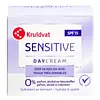Nivea Soothing Day Cream 24H Moisture Versus Kruidvat Sensitive SPF 15 Dagcrème Voor De Zeer Gevoelige Huid (SPF 15 Day Cream for Very Sensitive Skin)
What's inside
What's inside
 Key Ingredients
Key Ingredients

 Benefits
Benefits

 Concerns
Concerns

 Ingredients Side-by-side
Ingredients Side-by-side

Water
Skin ConditioningGlycerin
HumectantEthylhexyl Salicylate
UV AbsorberC12-15 Alkyl Benzoate
AntimicrobialMethylpropanediol
SolventCetearyl Alcohol
EmollientButyl Methoxydibenzoylmethane
UV AbsorberCaprylic/Capric Triglyceride
MaskingGlyceryl Stearate
EmollientTapioca Starch
Hydroxypropyl Starch Phosphate
Bis-Ethylhexyloxyphenol Methoxyphenyl Triazine
Skin ConditioningDistarch Phosphate
AbsorbentGlycyrrhiza Inflata Root Extract
Skin ConditioningVitis Vinifera
MaskingVitis Vinifera Seed Oil
EmollientSodium Stearoyl Glutamate
CleansingButyrospermum Parkii Butter
Skin ConditioningEthylhexylglycerin
Skin ConditioningHydroxyacetophenone
AntioxidantXanthan Gum
EmulsifyingPhenylbenzimidazole Sulfonic Acid
UV AbsorberTrisodium EDTA
Sodium Chloride
MaskingSodium Hydroxide
BufferingPhenoxyethanol
PreservativeWater, Glycerin, Ethylhexyl Salicylate, C12-15 Alkyl Benzoate, Methylpropanediol, Cetearyl Alcohol, Butyl Methoxydibenzoylmethane, Caprylic/Capric Triglyceride, Glyceryl Stearate, Tapioca Starch, Hydroxypropyl Starch Phosphate, Bis-Ethylhexyloxyphenol Methoxyphenyl Triazine, Distarch Phosphate, Glycyrrhiza Inflata Root Extract, Vitis Vinifera, Vitis Vinifera Seed Oil, Sodium Stearoyl Glutamate, Butyrospermum Parkii Butter, Ethylhexylglycerin, Hydroxyacetophenone, Xanthan Gum, Phenylbenzimidazole Sulfonic Acid, Trisodium EDTA, Sodium Chloride, Sodium Hydroxide, Phenoxyethanol
Water
Skin ConditioningOctocrylene
UV AbsorberDicaprylyl Ether
EmollientHomosalate
Skin ConditioningGlycerin
HumectantC12-15 Alkyl Benzoate
AntimicrobialCetearyl Alcohol
EmollientButyl Methoxydibenzoylmethane
UV AbsorberEthylhexyl Triazone
UV AbsorberSodium Polyacrylate
AbsorbentPhragmites Communis Extract
Skin ConditioningPoria Cocos Extract
Skin ConditioningSodium Stearoyl Glutamate
CleansingCaprylyl Glycol
EmollientEthylhexylglycerin
Skin ConditioningTetrasodium Glutamate Diacetate
Phenoxyethanol
PreservativeSodium Benzoate
MaskingTocopherol
AntioxidantWater, Octocrylene, Dicaprylyl Ether, Homosalate, Glycerin, C12-15 Alkyl Benzoate, Cetearyl Alcohol, Butyl Methoxydibenzoylmethane, Ethylhexyl Triazone, Sodium Polyacrylate, Phragmites Communis Extract, Poria Cocos Extract, Sodium Stearoyl Glutamate, Caprylyl Glycol, Ethylhexylglycerin, Tetrasodium Glutamate Diacetate, Phenoxyethanol, Sodium Benzoate, Tocopherol
Ingredients Explained
These ingredients are found in both products.
Ingredients higher up in an ingredient list are typically present in a larger amount.
Also known as Avobenzone, this ingredient is a chemical sunscreen filter that provides protection in the UV-A range.
Avobenzone is globally approved and is the most commonly used UV-A filter in the world.
Studies have found that avobenzone becomes ineffective when exposed to UV light (it is not photostable; meaning that it breaks down in sunlight). Because of this, formulations that include avobenzone will usually contain stabilizers such as octocrylene.
However, some modern formulations (looking at you, EU!) are able to stabilize avobenzone by coating the molecules.
Avobenzone does not protect against the UV-B range, so it's important to check that the sunscreen you're using contains other UV filters that do!
The highest concentration of avobenzone permitted is 3% in the US, and 5% in the EU.
Learn more about Butyl MethoxydibenzoylmethaneC12-15 Alkyl Benzoate is made up of Benzoic Acid and long chain alcohols. It has a low molecular weight.
C12-15 Alkyl Benzoate is an emollient and texture enhancer. Due to its solubility, it is often used in sunscreens to help evenly distribute active ingredients.
As an emollient, C12-15 Alkyl Benzoate helps soften and hydrate your skin. Emollients create a film on your skin that traps moisture within.
This ingredient has been reported to cause eye irritation.
Learn more about C12-15 Alkyl BenzoateCetearyl alcohol is a mixture of two fatty alcohols: cetyl alcohol and stearyl alcohol. It is mainly used as an emulsifier. Emulsifiers help prevent the separation of oils and products. Due to its composition, it can also be used to thicken a product or help create foam.
Cetearyl alcohol is an emollient. Emollients help soothe and hydrate the skin by trapping moisture.
Studies show Cetearyl alcohol is non-toxic and non-irritating. The FDA allows products labeled "alcohol-free" to have fatty alcohols.
This ingredient is usually derived from plant oils such as palm, vegetable, or coconut oils. There is debate on whether this ingredient will cause acne.
Due to the fatty acid base, this ingredient may not be Malassezia folliculitis safe.
Learn more about Cetearyl AlcoholEthylhexylglycerin (we can't pronounce this either) is commonly used as a preservative and skin softener. It is derived from glyceryl.
You might see Ethylhexylglycerin often paired with other preservatives such as phenoxyethanol. Ethylhexylglycerin has been found to increase the effectiveness of these other preservatives.
Glycerin is already naturally found in your skin. It helps moisturize and protect your skin.
A study from 2016 found glycerin to be more effective as a humectant than AHAs and hyaluronic acid.
As a humectant, it helps the skin stay hydrated by pulling moisture to your skin. The low molecular weight of glycerin allows it to pull moisture into the deeper layers of your skin.
Hydrated skin improves your skin barrier; Your skin barrier helps protect against irritants and bacteria.
Glycerin has also been found to have antimicrobial and antiviral properties. Due to these properties, glycerin is often used in wound and burn treatments.
In cosmetics, glycerin is usually derived from plants such as soybean or palm. However, it can also be sourced from animals, such as tallow or animal fat.
This ingredient is organic, colorless, odorless, and non-toxic.
Glycerin is the name for this ingredient in American English. British English uses Glycerol/Glycerine.
Learn more about GlycerinPhenoxyethanol is a preservative that has germicide, antimicrobial, and aromatic properties. Studies show that phenoxyethanol can prevent microbial growth. By itself, it has a scent that is similar to that of a rose.
It's often used in formulations along with Caprylyl Glycol to preserve the shelf life of products.
Sodium Stearoyl Glutamate is an emulsifier and helps condition the skin. It is amino acid-based.
In higher amounts, it may act as a cleansing agent.
Water. It's the most common cosmetic ingredient of all. You'll usually see it at the top of ingredient lists, meaning that it makes up the largest part of the product.
So why is it so popular? Water most often acts as a solvent - this means that it helps dissolve other ingredients into the formulation.
You'll also recognize water as that liquid we all need to stay alive. If you see this, drink a glass of water. Stay hydrated!
Learn more about Water